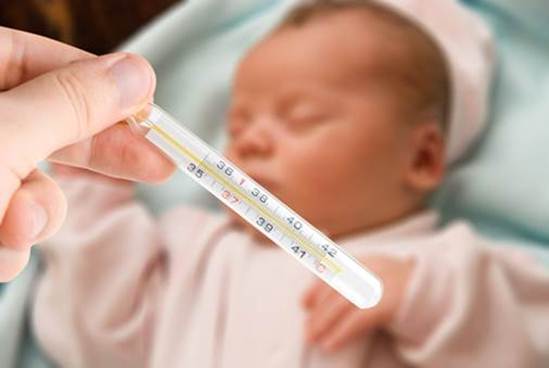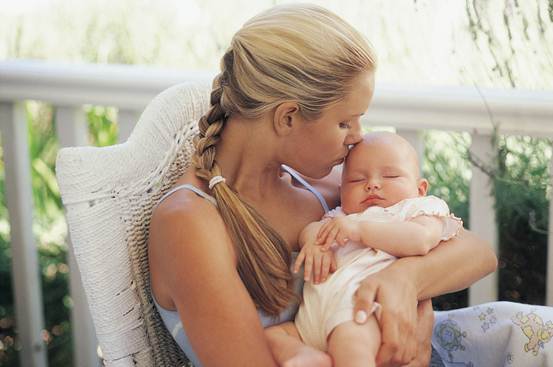In which case you can handle things happening to your
children yourself, and in which case you cannot? The followings are emergency
situations that you need to take your children to hospital.
Children have fevers at 3 months old or under 1 year old. In which case
should you take them to hospital?
If children are under 3 months old and have over-380C
fevers, they are having health abnormalities. Children may simply just have a
cold, but there’re chances it’s a sign of meningitis. What you need to do then
is to take them to hospital immediately. To ensure the preciseness of the results
of children’s temperatures, you should take their rectal temperatures.

Children may
simply just have a cold, but there’re chances it’s a sign of meningitis.
Contrariwise, if children under 1 year old have 38.50C
fevers, moms shouldn’t be so worried about it or rush in taking the children to
the hospital. You’d better learn to check the signs on children at that age
rather than just take information from the number on thermometers.
Fever is a process of self-protection. If a child has a
fever, his/her immune system is working. Fever is technically detected when the
temperature of the straight intestine reaches 380C. If you take axillary
temperatures, make sure you add 1 degree to have the close result to the real
temperature.
To children who are 1 year old and older, you can let them
have acetaminophen or paracetamol to reduce the fever. However, make sure it’s a
necessary case and your children have the right dose according to the
instruction of the pill. Remember that antipyretics aren’t able to fight
against infectious diseases that cause fever.
And, if children are not so tired, still have normal eating,
you can skip the hospitalizing your children. The fever that happens in
children who are under 1 year old willgo away by itself; it’s not necessary to
have immediate treatments.
Of course, if children have fevers in 4 successive days, you
should hospitalize them.
Children fall from high places
This may be the most considering thing to parents.

Children who
practice crawling/ walking easily have accidents related to falling.
Every time your children fall from beds, chairs, cradles or
tables…, you need to check them carefully, and if necessary, you can take them
to hospital to have complete checkup. The checkups get more important in the
case that children fall on their back or head.
We often worry about the fact children can get broken bones,
injuries or damages in internal parts, such as head injury (broken skull…).
Although the falling is serious, infants who learn to crawl or walk have soft
bones which reduce the chance of being broken. If children don’t cry too much
and have normal regimens, the fall doesn’t cause severe injuries. However, you
still have to observe the children’s reactions in at least 24 hours after the
fall.
So, what kind of falls should parents worry about?
·
Faints, unconsciousness, apnea or breathlessness
·
Continuous bleeding
·
Having an epileptic fit
·
Children take too deep sleep that you cannot wake them.
·
Signs of broken bones: a part of the body is deformed.
·
Signs of a broken skull: a part of the scalp is soft and swelling,
the white parts of eyes have red gleams, light-pink liquid is coming out from
the nose and ears.
·
Signs of internal injuries: repeating vomiting, deep sleeps,
dizziness, headache, crying too long a time and screaming for hours
Heat rash, rash and eruptions
Rashes that happen to children are often benign and go away
soon. Most parents who have children having rash try to handle it themselves by
applying traditional methods like letting children take a bath with tea leaves
or bitter melon…. Nonetheless, if the red streaks in children’s skin increase
strongly, spread or last for days, you should take them to hospital.

All you have to do
is to take care of your children and make good decisions based on the mother
instinct.
There’s a small tip that help you to distinguish benign
rashes and rashes related to severe diseases: press a rash spot, if the spot
gets faded or have its color switches to the skin color, it’s normal rash. Most
of the viruses that cause rash and heat rash exhibit like that.
However, if the rash spot doesn’t change color when you
press on it, you should take the children to hospitals immediately as the sign
is closely relative to meningitis or blood infection, especially when it comes
with fevers.
Fevers, falls and rashes are the 3 cases that disturb
parents with the idea whether they should take care of their children at home
or take the children to hospital. Remember that no matter how stable your
knowledge and theories are, all you have to do is taking care of your children
and making good decisions based on the mother instinct.